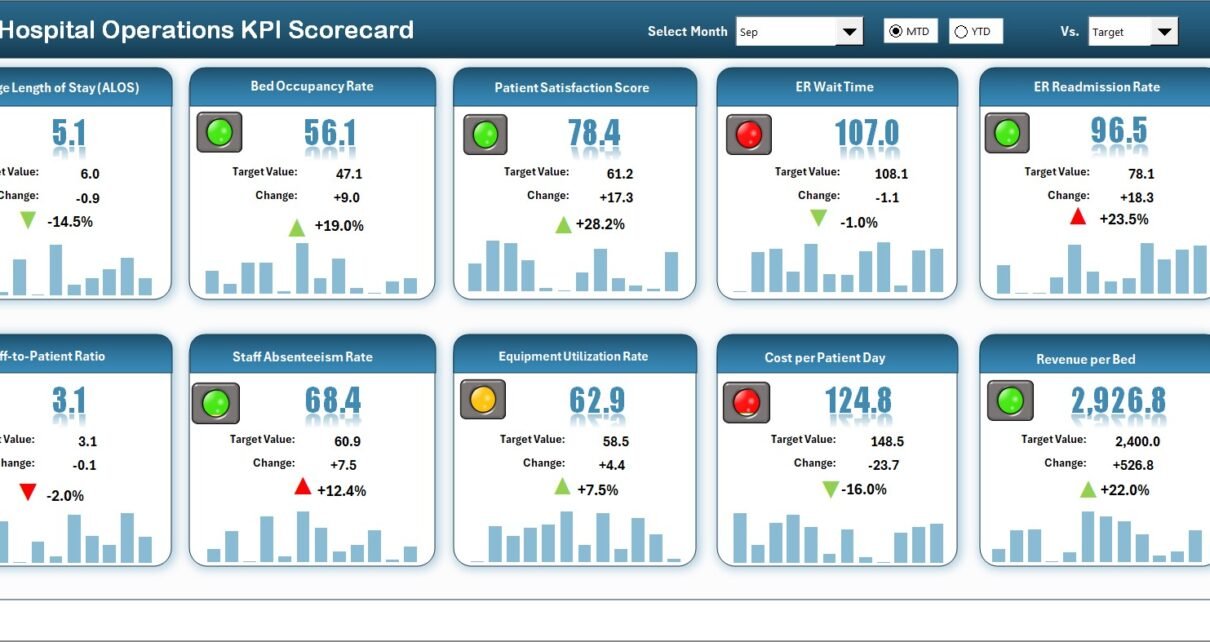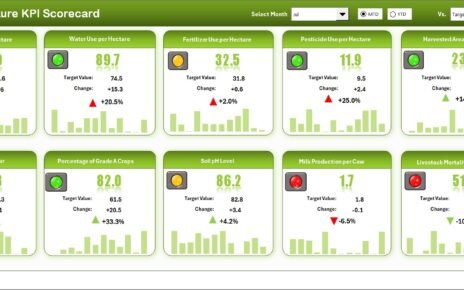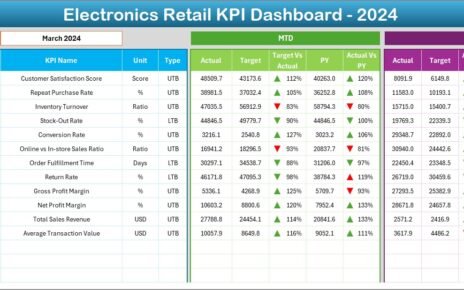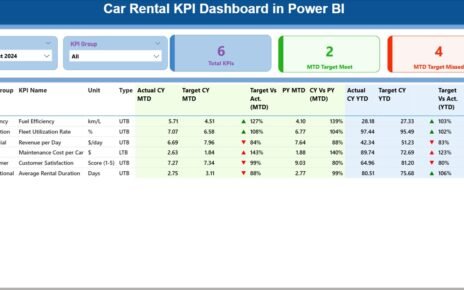Running a hospital efficiently requires balancing patient care quality, financial performance, resource utilization, and operational excellence. But managing all these factors manually can be overwhelming. That’s where the Hospital Operations KPI Scorecard in Excel comes in — a powerful, ready-to-use tool that helps healthcare administrators track, measure, and optimize their hospital’s key performance indicators (KPIs) with ease.
This Excel-based scorecard provides an interactive way to visualize performance metrics across departments, monitor trends, and make data-driven decisions that lead to better patient outcomes and operational efficiency.
Click to Purchases Hospital Operations KPI Scorecard in Excel
What Is a Hospital Operations KPI Scorecard in Excel?
A Hospital Operations KPI Scorecard is a structured performance-tracking system that consolidates key hospital metrics into one easy-to-use Excel dashboard. It provides a real-time view of how well different departments are performing against their goals.
Instead of going through multiple reports and spreadsheets, this scorecard presents all key data in one central dashboard — enabling managers and hospital executives to assess performance quickly and take corrective actions.
Why Use Excel for Hospital KPI Tracking?
Excel remains one of the most flexible and accessible tools for performance management. It allows you to:
-
Track both Month-to-Date (MTD) and Year-to-Date (YTD) KPIs.
-
Automate calculations using built-in formulas.
-
Create dynamic visuals with color-coded indicators and charts.
-
Customize the KPI list and targets to fit your hospital’s unique needs.
-
Share and update performance data easily without needing advanced software.
Structure of the Hospital Operations KPI Scorecard in Excel
The template comes with four well-designed worksheets, each serving a specific purpose in your performance tracking process.
1. Scorecard Sheet – The Main Dashboard
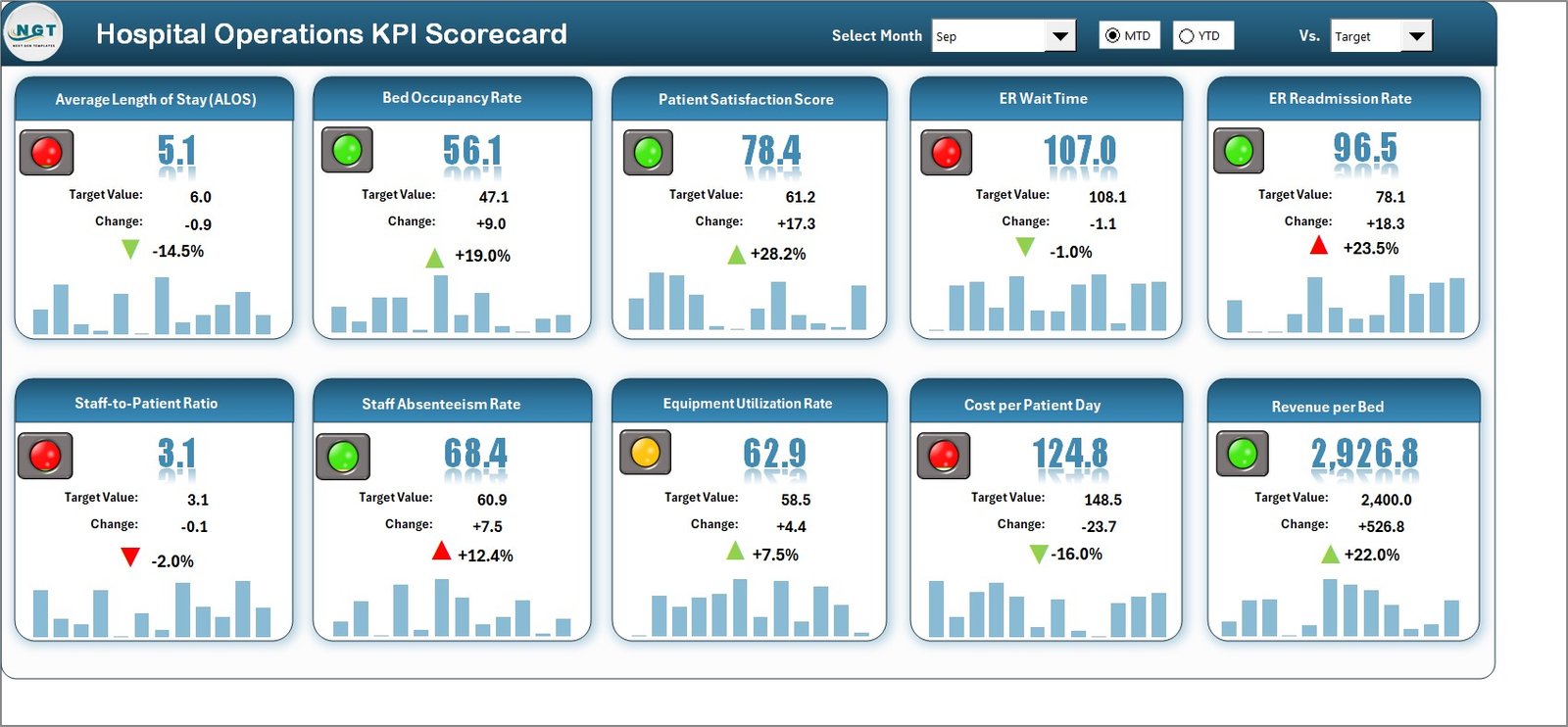
The Scorecard Sheet is the main interface where you can view overall hospital performance at a glance. It acts as your real-time performance monitor.
Key Features:
-
🟩 Dropdown Menus:
Select your preferred time frame — Month-to-Date (MTD) or Year-to-Date (YTD) — for focused analysis. -
📊 Actual vs. Target Values:
Compare actual performance against predefined targets for every KPI. -
🧭 Visual Indicators:
Use color-coded visuals (green, yellow, red) to instantly understand which KPIs are on track, behind schedule, or need immediate attention. -
📘 Comprehensive KPI Overview:
The sheet lists all key hospital KPIs — including patient satisfaction, bed occupancy rate, staff efficiency, and average treatment cost — along with trend comparisons.
This sheet provides the big picture needed for executives and department heads to make quick, data-driven decisions.
2. KPI Trend Sheet – Analyze KPI Performance Over Time
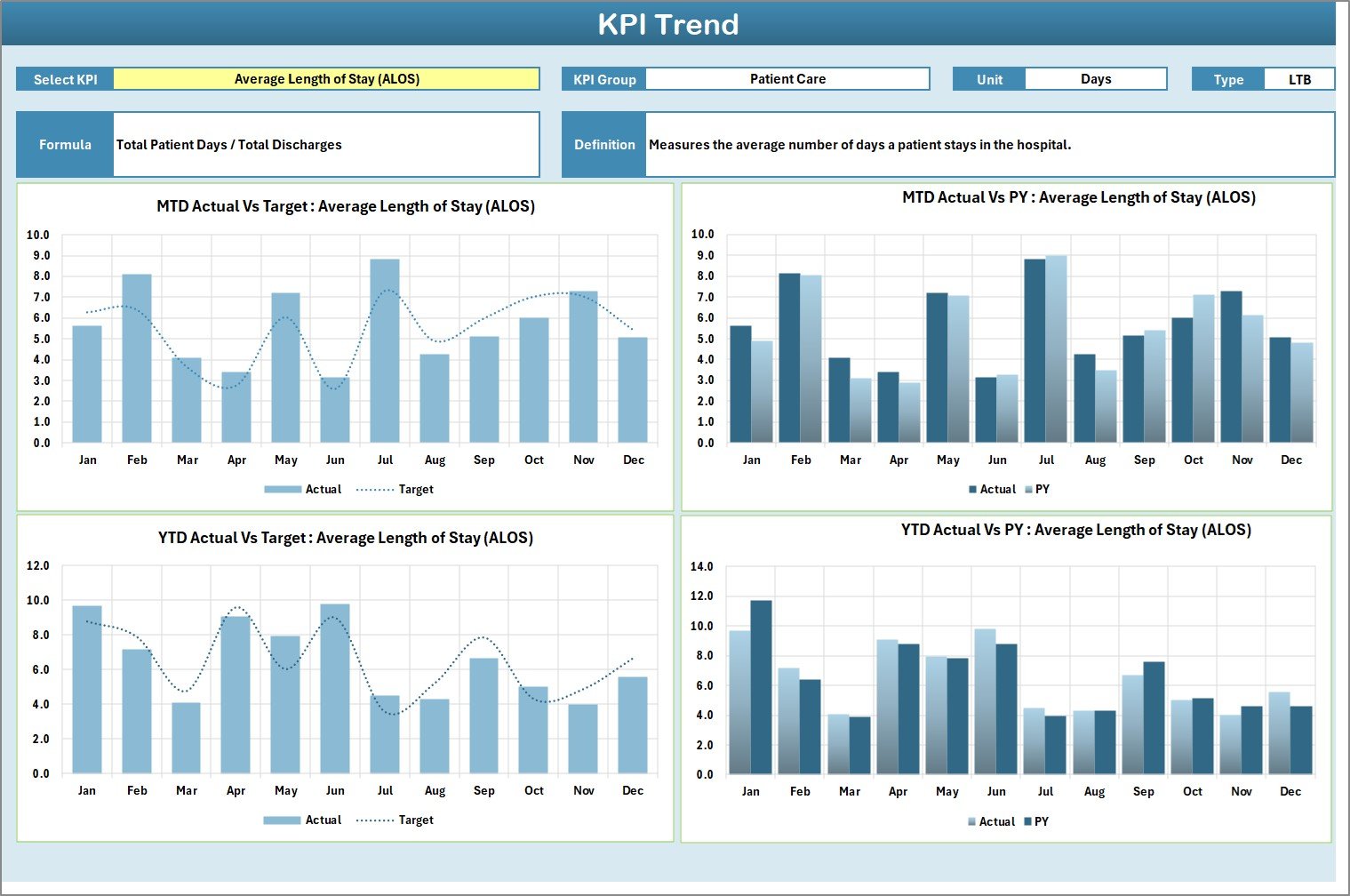
The KPI Trend Sheet allows you to explore trends and variations in KPI performance over time.
Key Features:
-
🎯 Dropdown Selection:
Choose any KPI from a dropdown menu (in cell C3) to visualize its performance trend. -
📈 MTD and YTD Analysis:
View side-by-side charts showing Month-to-Date and Year-to-Date performance. -
📚 KPI Details:
See details such as KPI Group, Unit, Type (UTB – Upper the Better / LTB – Lower the Better), Formula, and Definition.
This helps in identifying long-term trends — for instance, whether patient waiting times are improving or average treatment costs are decreasing over months.
3. Input Data Sheet – Your Data Entry Hub
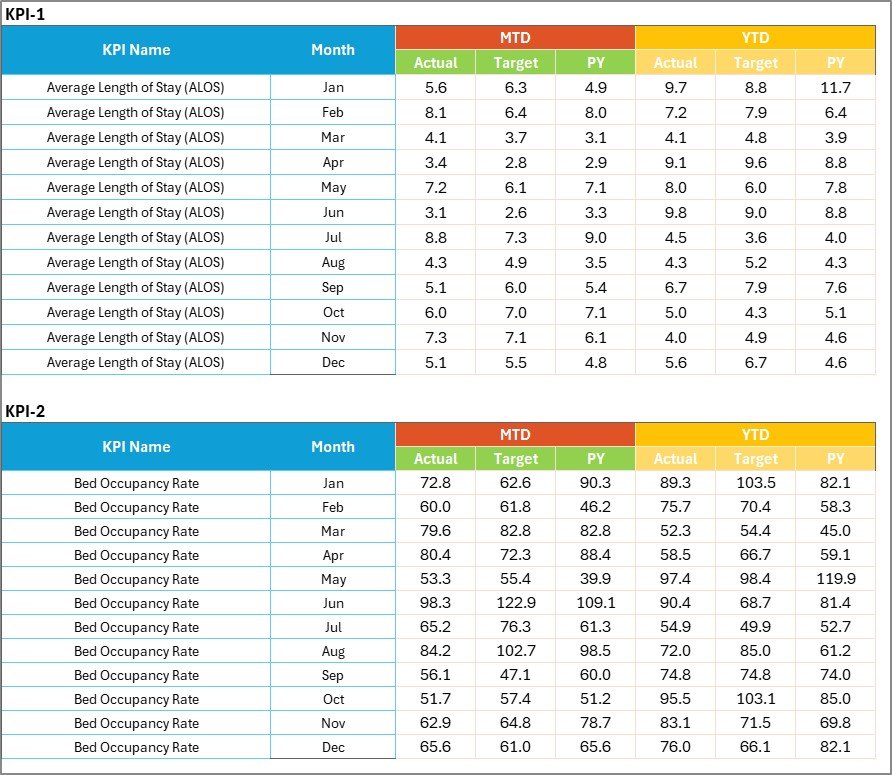
The Input Data Sheet serves as the foundation of the scorecard. This is where you record all performance data.
Key Features:
-
🧾 Data Entry Section:
Input the actual performance, target, and previous year (PY) values for each KPI. -
🔁 Automatic Updates:
Once data is entered, all charts and tables in other sheets automatically refresh. -
⚙️ Flexibility:
Add or modify KPIs as your hospital’s priorities evolve — such as introducing new metrics for emergency response time or infection control rate.
This sheet ensures the dashboard always reflects the most accurate and current data.
4. KPI Definition Sheet – Your Reference Library

The KPI Definition Sheet maintains a structured list of all KPIs being tracked.
Key Features:
-
📄 KPI Information:
Define each KPI’s group, unit, formula, and purpose. -
📘 Clarity in Understanding:
Every hospital staff member can understand what each metric means and how it’s calculated.
This sheet ensures everyone in the organization speaks the same “KPI language,” promoting consistency and transparency in reporting.
Click to Purchases Hospital Operations KPI Scorecard in Excel
How the Hospital Operations KPI Scorecard Works
The scorecard is built entirely in Excel with automated calculations and linked charts. Here’s how it functions:
-
Input Your Data:
Enter the monthly actuals, targets, and previous year’s data in the Input Data Sheet. -
KPI Definition Alignment:
Each KPI references its group, unit, and formula from the Definition Sheet. -
Automatic Scorecard Update:
The main Scorecard Sheet instantly reflects changes using formulas and conditional formatting. -
Visual Insights:
The KPI Trend Sheet visualizes monthly progress, making it easy to identify problem areas and achievements. -
Action-Oriented Insights:
Decision-makers can review underperforming KPIs and assign corrective actions.
Advantages of Using the Hospital Operations KPI Scorecard in Excel
Let’s look at why every hospital should consider adopting this Excel-based scorecard system.
1. Centralized Performance Monitoring
All critical KPIs — from patient satisfaction to revenue — appear in one unified view. This eliminates the need to compile multiple reports from different departments.
2. Improved Decision-Making
By comparing actual performance with targets, management can quickly identify strengths and weaknesses and take corrective action before problems escalate.
3. Real-Time Updates
As soon as you enter new data, charts and visuals update automatically. This ensures everyone works with the most recent and accurate information.
4. Easy to Customize
Hospitals differ in their structure and operations. Excel allows you to modify KPIs, charts, and thresholds to suit your organization’s needs.
5. Cost-Effective Solution
Unlike expensive software systems, Excel-based scorecards require no additional licensing fees, making them perfect for small and mid-sized hospitals.
6. Enhanced Communication
Color-coded visuals and clear reports improve communication among doctors, nurses, administrators, and financial teams.
Click to Purchases Hospital Operations KPI Scorecard in Excel
How to Use the Hospital Operations KPI Scorecard Effectively
To get the best results, follow this step-by-step approach:
-
Define Your KPIs Clearly:
Select measurable KPIs that align with your hospital’s strategic goals. -
Set Monthly and Annual Targets:
Ensure every KPI has clear targets for MTD and YTD performance comparison. -
Input Data Consistently:
Update the Input Data Sheet regularly (weekly or monthly) to keep insights fresh. -
Use Color-Coding for Alerts:
Set thresholds to highlight performance issues automatically. -
Analyze Trends Monthly:
Review charts in the KPI Trend Sheet to identify improvement opportunities. -
Share Reports with Departments:
Encourage each department to review their KPIs and discuss improvement plans.
Best Practices for the Hospital Operations KPI Scorecard
Here are some expert-recommended practices to maximize the benefits of your Excel scorecard.
-
✅ Limit the Number of KPIs:
Focus on 20-30 core KPIs to avoid clutter and maintain clarity. -
📅 Review KPIs Monthly:
Regular reviews help spot trends early and prevent operational inefficiencies. -
🧩 Involve Department Heads:
Let each department own its KPIs — this builds accountability and engagement. -
📊 Use Data Validation:
Apply dropdowns and consistent formats in your Input Sheet to avoid data entry errors. -
🧠 Keep Definitions Updated:
Regularly revisit KPI formulas and descriptions to align with new processes or policies. -
🔄 Benchmark Performance:
Compare your hospital’s performance with industry standards for a broader perspective.
Common Challenges Hospitals Face Without KPI Scorecards
Without a structured system like this, hospitals often struggle with:
-
Scattered data and inconsistent reports.
-
Difficulty in identifying underperforming areas.
-
Lack of visibility across departments.
-
Manual data compilation leading to errors.
-
Delayed decision-making due to poor data flow.
By implementing the Hospital Operations KPI Scorecard in Excel, these issues disappear — replaced by clarity, consistency, and control.
Click to Purchases Hospital Operations KPI Scorecard in Excel
How This Scorecard Supports Continuous Improvement
Continuous improvement is vital in healthcare. The scorecard promotes it by:
-
Encouraging regular performance monitoring.
-
Highlighting trends that require attention.
-
Providing quantifiable results for each improvement initiative.
-
Supporting strategic planning with accurate historical data.
Over time, this tool becomes the backbone of hospital management, guiding leadership decisions with reliable insights.
Real-World Applications of the Scorecard
Hospitals can use the scorecard in various practical ways:
-
Daily Ward Management: Track bed occupancy and patient turnaround.
-
Monthly Department Reviews: Evaluate surgery efficiency, pharmacy performance, and lab testing volumes.
-
Financial Oversight: Compare revenue targets and operational costs.
-
Patient Experience Analysis: Monitor satisfaction scores and complaint resolution rates.
-
Accreditation Preparation: Maintain performance records required for compliance audits.
Conclusion
The Hospital Operations KPI Scorecard in Excel is more than just a spreadsheet — it’s a strategic management tool that empowers hospitals to improve performance, reduce inefficiencies, and deliver better patient outcomes.
With its simple design, real-time analytics, and cost-effective implementation, it bridges the gap between data and decision-making.
By consistently tracking your KPIs, analyzing trends, and acting on insights, your hospital can achieve measurable progress and sustainable success.
Click to Purchases Hospital Operations KPI Scorecard in Excel
Frequently Asked Questions (FAQs)
1. What is a Hospital Operations KPI Scorecard used for?
It tracks and analyzes key metrics such as patient care quality, resource utilization, and financial performance, helping hospitals make data-driven decisions.
2. Can I customize the KPIs in the Excel scorecard?
Yes, you can easily modify or add KPIs to match your hospital’s unique goals and priorities.
3. Is the scorecard suitable for small hospitals or clinics?
Absolutely. It’s designed to be scalable and works perfectly for both small clinics and large healthcare institutions.
4. Does the scorecard update automatically?
Yes. Once you enter data in the Input Sheet, all visuals and summaries refresh automatically using Excel formulas and conditional formatting.
5. What kind of KPIs should hospitals track?
Common KPIs include patient satisfaction, bed occupancy rate, staff efficiency, infection rate, average treatment cost, and revenue per patient.
6. How often should hospitals review KPIs?
Monthly reviews are ideal, but some critical KPIs (like emergency response time) can be monitored weekly for faster action.
7. What makes Excel a good platform for hospital scorecards?
Excel is widely accessible, cost-effective, and supports advanced features like pivot charts, slicers, and conditional formatting — perfect for KPI analysis.
Click to Purchases Hospital Operations KPI Scorecard in Excel
Visit our YouTube channel to learn step-by-step video tutorials
